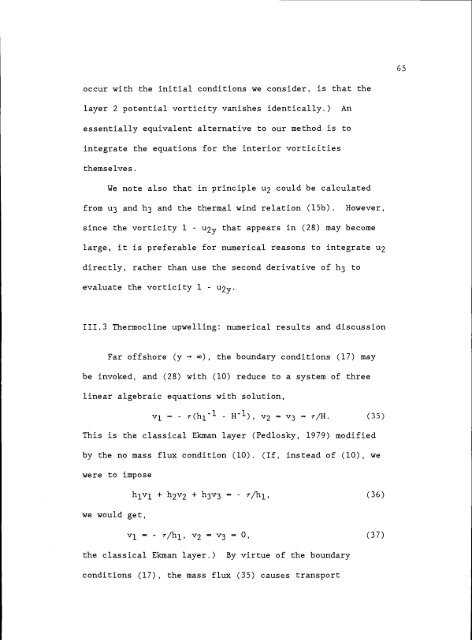Observations and Modelling of Fronts and Frontogenesis
Observations and Modelling of Fronts and Frontogenesis
Observations and Modelling of Fronts and Frontogenesis
Create successful ePaper yourself
Turn your PDF publications into a flip-book with our unique Google optimized e-Paper software.
occur with the initial conditions we consider, is that the<br />
layer 2 potential vorticity vanishes identically.) An<br />
essentially equivalent alternative to our method is to<br />
integrate the equations for the interior vorticities<br />
themselves.<br />
We note also that in principle u2 could be calculated<br />
from u3 <strong>and</strong> h3 <strong>and</strong> the thermal wind relation (15b). However,<br />
since the vorticity 1 U2y that appears in (28) may become<br />
large, it is preferable for numerical reasons to integrate u2<br />
directly, rather than use the second derivative <strong>of</strong> h3 to<br />
evaluate the vorticity 1 U2y.<br />
111.3 Thermocline upwelling: numerical results <strong>and</strong> discussion<br />
Far <strong>of</strong>fshore (y co), the boundary conditions (17) may<br />
be invoked, <strong>and</strong> (28) with (10) reduce to a system <strong>of</strong> three<br />
linear algebraic equations with solution,<br />
V1 = - r(h1 - 111), v2 = = r/H. (35)<br />
This is the classical Ekman layer (Pedlosky, 1979) modified<br />
by the no mass flux condition (10). (If, instead <strong>of</strong> (10), we<br />
were to impose<br />
we would get,<br />
h1v1 + h2v2 + h3v3 r/h1, (36)<br />
v1 - r/h1, v2 = v3 = 0, (37)<br />
the classical Ekman layer.) 3y virtue <strong>of</strong> the boundary<br />
conditions (17), the mass flux (35) causes transport<br />
65















